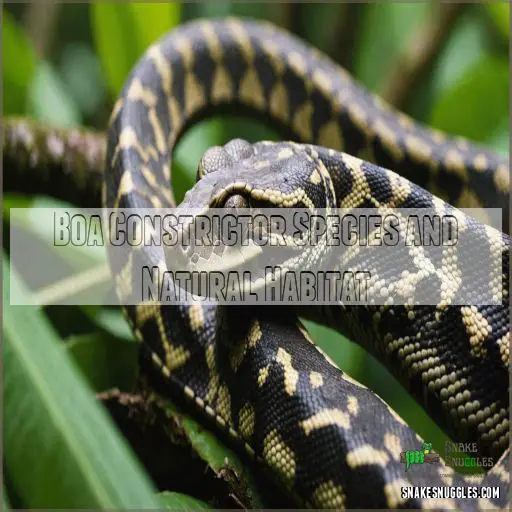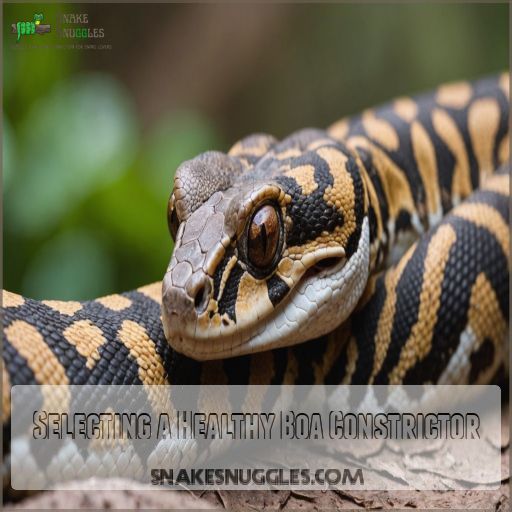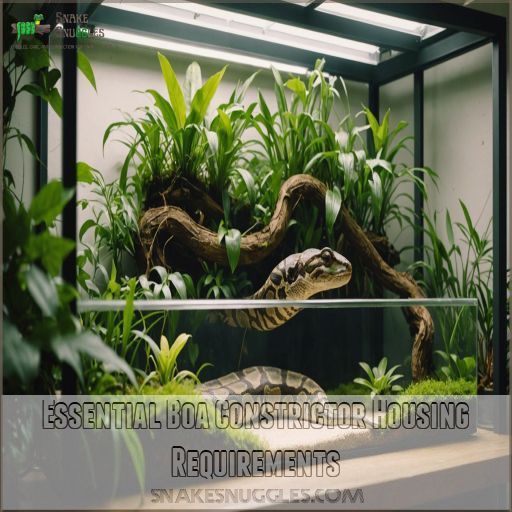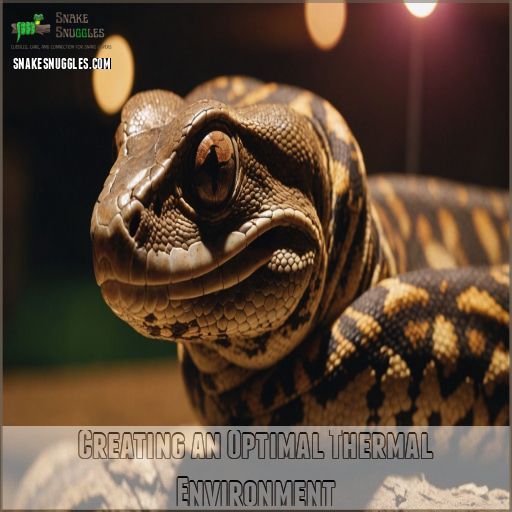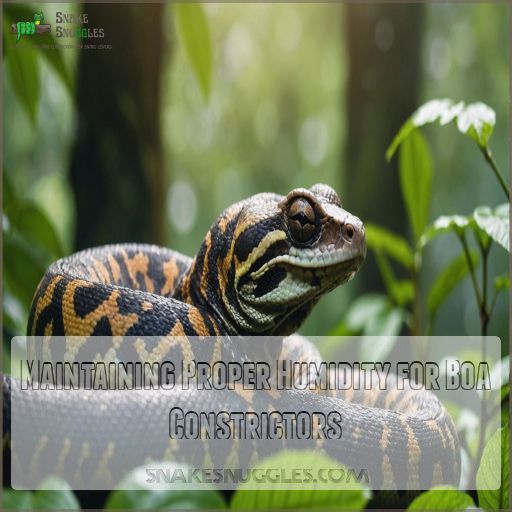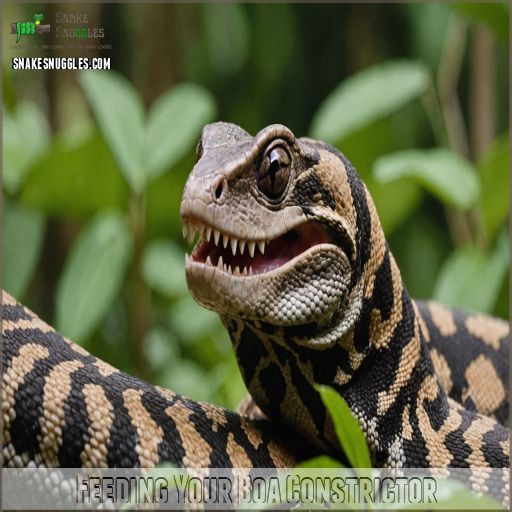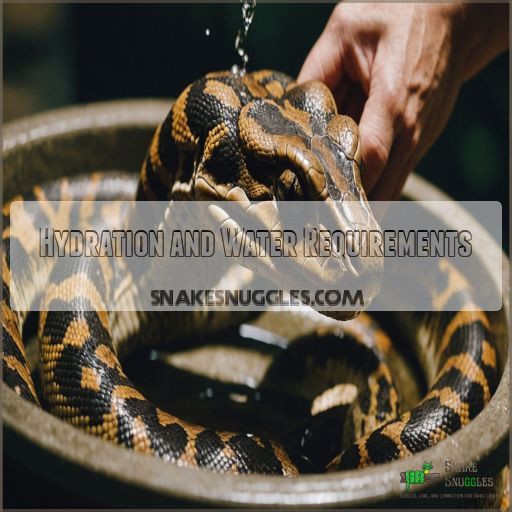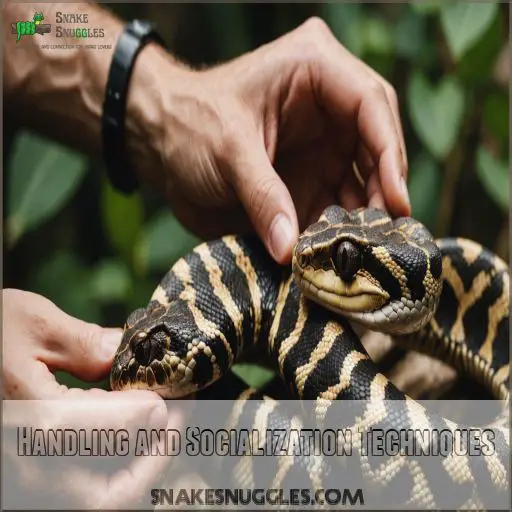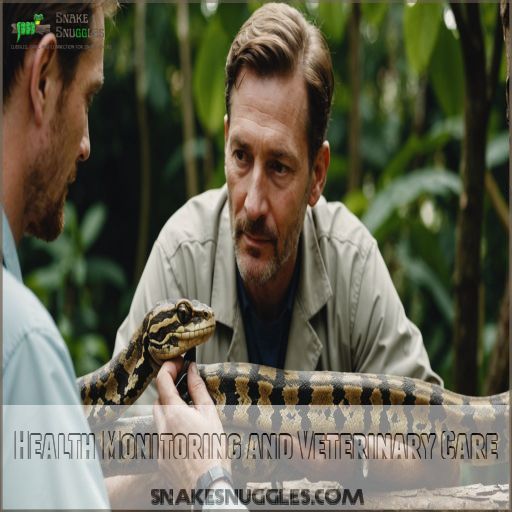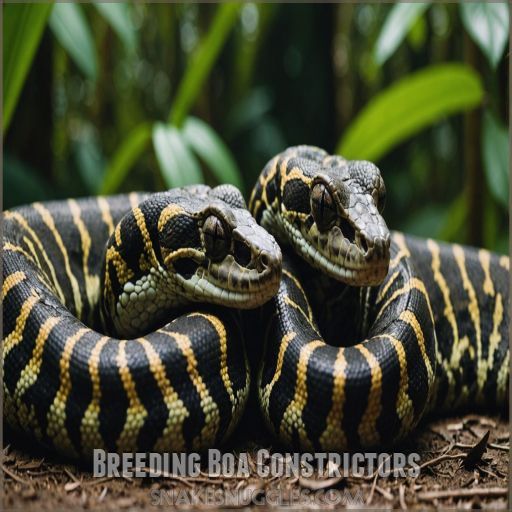This site is supported by our readers. We may earn a commission, at no cost to you, if you purchase through links.
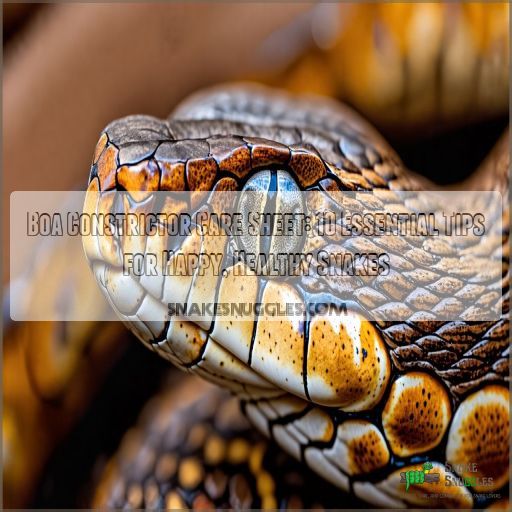
Your boa’s home should include climbing branches, hideouts, and a water dish. Feed them appropriately-sized prey, increasing as they grow.
Handle your boa regularly, but respect their boundaries. Keep an eye out for health issues like respiratory infections or mites.
Remember, a happy boa is a healthy boa! With proper care, your scaly friend can live 20-30 years. But there’s more to learn about these amazing creatures – stick around to uncover the secrets of successful boa constrictor care.
They are indeed fascinating reptiles and with the right environment, they can thrive. A temperature gradient and spacious enclosure are key to a happy boa, and don’t forget they can be your scaly friend for a long time.
Table Of Contents
- Key Takeaways
- Boa Constrictor Species and Natural Habitat
- Selecting a Healthy Boa Constrictor
- Essential Boa Constrictor Housing Requirements
- Creating an Optimal Thermal Environment
- Maintaining Proper Humidity for Boa Constrictors
- Feeding Your Boa Constrictor
- Hydration and Water Requirements
- Handling and Socialization Techniques
- Health Monitoring and Veterinary Care
- Breeding Boa Constrictors
- Frequently Asked Questions (FAQs)
- How to care for a boa constrictor?
- What equipment do I need for a boa constrictor?
- What are boa constrictors?
- Do boa constrictors have health problems?
- How often should I clean my boas enclosure?
- Can boa constrictors be housed together?
- What substrate is best for boa constrictors?
- How do I safely transport my boa constrictor?
- Are there any legal restrictions on owning boas?
- Conclusion
Key Takeaways
- You’ll need to create a tropical paradise for your boa, complete with a spacious enclosure, proper heating (an 88-95°F basking spot), and humidity levels (55-75%). Think of yourself as a snake spa manager, ensuring your slithery friend has all the comforts of home.
- Feeding your boa is like serving up a snake-sized burger – choose prey that’s no thicker than your snake’s widest part. You’ll need to adjust the menu as your boa grows, from hopper mice for the youngsters to jumbo rats for the adults. Remember, a well-fed boa isn’t always a healthy one, so keep an eye on their body condition.
- Handling your boa is like building a friendship – it takes time and patience. Start with short, sweet sessions of 5-10 minutes every few days, and gradually increase them as trust builds. You’re not just a snake owner; you’re a snake whisperer in training!
- Regular health check-ups are crucial – you’ll need to be a snake detective, keeping an eye out for common issues like respiratory infections, parasites, and shedding problems. Find a reptile-savvy vet and establish a relationship early. After all, a healthy boa is a happy boa, and with proper care, your scaly friend could be your companion for up to 30 years!
Boa Constrictor Species and Natural Habitat
You’ll find over 40 species of boa constrictors across South America, Central America, and the Caribbean, each with unique traits and sizes.
These impressive snakes have adapted to various habitats, from tropical rainforests to dry savannas, making them a fascinating study in reptilian diversity.
Boa Constrictor Subspecies and Varieties
Diving into the realm of boa constrictors, you’ll find a rainbow of subspecies and morphs.
The Boa genus boasts three known species: Boa constrictor, Boa imperator, and Boa sigma.
Within these, you’ll encounter eight official subspecies of B. constrictor, each with unique traits.
From the "True Red-Tailed Boa" (B. c. constrictor) to the silvery Argentine Boa (B. c. occidentalis), these snakes offer a fascinating variety of colors and patterns.
Geographic Distribution and Native Habitats
The New World’s slithering sensation, the boa constrictor, calls a vast swath of the Americas home.
You’ll find these adaptable serpents from Mexico to Argentina, even sunbathing on Caribbean islands. They’re not picky tenants, thriving in rainforests, grasslands, and even your backyard [3).
But watch out, Florida! Some boas have crashed the party, turning invasive and threatening local critters. It’s a wild world out there for these versatile constrictors with a talent for being adaptatable serpents.
Physical Characteristics and Size Variations
As you explore boa constrictor species, you’ll notice striking variations in their neotropical snake species appearance
.
Their size ranges are impressive, with some reaching up to 4 meters long.
Their coloration and patterns are a feast for the eyes, featuring intricate designs of brown and black against lighter backgrounds. You’ll find unique subspecies like B. c. ortonii with its distinctive red tail markings, or the silvery Argentine boa with its mesmerizing network pattern.
Natural Behaviors and Adaptations
Your boa constrictor’s natural behaviors are a fascinating mix of adaptations. These nocturnal hunters use heat-sensing pits to locate prey, relying on camouflage to stay hidden during the day.
In their native habitats, such as lush rainforests with humidity and ample cover, boa constrictors have adapted to thrive. With their steady growth rate and ability to reach 6 to 10 feet in length, it’s no wonder they’ve evolved to be skilled predators.
When it’s time to eat, they’re masters of prey constriction, squeezing their dinner tight. Don’t be alarmed if your boa gets a bit defensive – it’s just their way of saying "I need some space!"
Understanding these behaviors helps you become a better snake parent.
Selecting a Healthy Boa Constrictor
Choosing a healthy boa constrictor is like picking the perfect dance partner – you want one that’s active, alert, and ready to groove.
You’ll need to inspect the snake’s body condition, check for clear eyes and clean nostrils, and make sure there’s no sign of respiratory issues.
You also want to be aware of tiny, unwanted hitchhikers on your new slithery friend, which are actually mites.
Reputable Sources for Purchasing
Treasure hunters, finding your perfect boa constrictor can be an adventure!
Start by seeking reputable breeders who prioritize snake health over profit. Online marketplaces offer convenience, but exercise caution and verify seller credibility.
Pet stores may have limited options, while reptile shows provide face-to-face interactions with breeders.
Consider ethical sourcing, opting for captive-bred snakes over wild-caught specimens. Remember, choosing wisely means you’ll bring home a slithering companion ready for a long, healthy life together.
Signs of a Healthy Boa
Consistently, healthy boas display clear, bright eyes that sparkle with energy. You’ll notice their tongue flicking regularly, a sign of active exploration.
Look for smooth, intact skin and a robust body condition with good muscle mass.
During the shed cycle, they’ll shed their skin in one complete piece.
A relaxed demeanor and the ability to wrap securely around objects indicate overall well-being. A happy boa is a healthy boa!
Common Health Issues to Watch For
Vigilance is key regarding boa health.
Keep an eye out for stomatitis (mouth rot), respiratory infections, and parasites. Watch for signs of dysecdysis (shedding problems) or skin lesions.
Boas may also face serious threats like Inclusion Body Disease (IBD), which can cause neurological issues and regurgitation.
Regular check-ups with a reptile vet can help catch and treat these issues early, ensuring your slithery friend stays in top shape.
Quarantine Procedures for New Boas
Once you’ve found a healthy-looking boa, it’s time to play it safe with a quarantine period. Think of it as your new snake’s spa retreat! You’ll want to keep your scaly friend isolated for a while to make sure they’re not bringing any unwanted guests to the party.
Here’s what you need to do:
- Set up a separate enclosure for a 30-90 day isolation period
- Schedule an initial vet visit for a thorough health check
- Perform regular parasite checks during quarantine
- Observe behavior closely for any signs of illness or stress
Remember, patience is key. It might seem like overkill, but this quarantine time is your best defense against introducing diseases to your existing collection. Plus, it gives you a chance to bond with your new boa one-on-one. Who knows, you might even catch them doing their secret snake yoga routine!
Essential Boa Constrictor Housing Requirements
You’re about to become a boa constrictor landlord, and it’s time to create the ultimate snake pad.
From spacious enclosures to cozy hides, you’ll need to nail the essentials to keep your scaly tenant happy and healthy.
Enclosure Size and Type
Now that you’ve chosen your boa, let’s set up its home sweet home. Your boa’s enclosure is its kingdom, and size matters! You’ll need a spacious castle for your royal serpent.
Here’s a quick guide to keep your boa happy:
| Snake Length | Minimum Enclosure Size | Enclosure Type |
|---|---|---|
| < 2 feet | 2’L x 1.5’W x 1’H | Glass terrarium |
| 2-5 feet | 4’L x 2’W x 2’H | PVC or custom |
| 6-8+ feet | 6’L x 3’W x 3’H | Custom-built |
Remember, bigger is better! Your boa will thank you with royal slithers.
Substrate Options and Maintenance
Choosing the right substrate for your boa is like picking the perfect mattress – it’s all about comfort and practicality. Coconut fiber substrates, for example, offer excellent moisture retention, making them suitable for boa constrictors‘ humidity needs best bedding for boa constrictors.
Here are some top options to keep your scaly friend happy:
- DIY mix (40% topsoil, 40% ReptiSoil, 20% play sand): Natural, cheap, and great for humidity
- Cypress mulch: Smells nice and holds moisture well
- Paper towels: Ideal for quarantine or easy cleaning
Remember, substrate impacts humidity and cleanliness. Clean regularly to prevent mold and maintain a healthy environment for your slithery companion.
Heating and Lighting Setup
With your substrate sorted, let’s shed some light on heating and lighting.
Your boa’s enclosure should mimic a warm, sunny day in the tropics. You’ll need to create a temperature gradient that’ll have your snake doing the "hot-cold shuffle" to regulate its body heat.
Here’s a quick guide to keep your slithery friend comfy:
| Equipment | Purpose | Placement |
|---|---|---|
| Heat Lamps | Basking area | Cluster on one side |
| UVB Lamp | Daylight simulation | Near heat lamps |
| Heat Mat | Belly warmth | Under warm hide |
| Thermostat | Temperature control | Probe in warm hide |
| Night Lamp | Nocturnal viewing | Optional, red or blue |
Humidity Control and Monitoring
While you’ve got your boa’s heat dialed in, let’s slither into humidity. Your scaly friend needs moisture levels between 55-75% to thrive. Think of it as a tropical spa day, every day!
Grab a digital hygrometer – it’s your new best friend for keeping tabs on that steamy atmosphere. Don’t sweat it if readings fluctuate; that’s natural and even beneficial for your boa’s health.
Now that you’re equipped to monitor the atmosphere, keeping your boa happy is a breeze.
Furnishings and Enrichment Items
Once you’ve got the humidity dialed in, it’s time to make your boa’s home a snake paradise.
Climbing branches aren’t just for monkeys – your boa will love slithering up and down them (Source).
Hideout boxes give your snake a cozy retreat when it needs some alone time.
Don’t forget a sturdy water dish for soaking and sipping.
Artificial terrarium plants add a touch of the wild, while enrichment toys keep your boa’s mind sharp.
It’s like snake feng shui, where climbing branches add to the overall ambiance.
Creating an Optimal Thermal Environment
You’ll need to create a cozy heat haven for your boa constrictor, mimicking the warmth of its native habitat.
By setting up the right thermal environment, you’re not just keeping your snake comfortable; you’re helping it thrive and avoid the chills that can lead to health issues.
Temperature Gradient Importance
Creating a temperature gradient is like giving your boa constrictor a personal thermostat. You’ll want to set up a warm side and a cool side in their enclosure, allowing them to regulate their body temperature naturally. This thermal highway is key for your snake’s health and happiness.
Here’s why a temperature gradient matters:
- Aids digestion after meals
- Promotes natural behaviors
- Supports immune function
- Helps with shedding process
By providing this range, you’re in effect letting your boa choose its perfect spot. They’ll bask when they need warmth and cool off when necessary. It’s like giving them a temperature buffet – they’ll slither to whatever feels just right (Source).
Basking Spot Temperatures
Now that you’ve nailed the temperature gradient, let’s turn up the heat on basking spots. Your boa’s sunbathing oasis should be a toasty 88-95°F. Place heat lamps strategically to create this warm zone, using a cluster of at least two bulbs for even heating.
To get the best results, make sure the basking area is large enough for your snake to stretch out comfortably.
Mimicking natural seasonal variations by adjusting the ambient temperature slightly throughout the year, as seen in ideal thermal environments.
Remember, your scaly friend’s behavior is the best thermometer – if they’re always basking, bump it up a notch. It’s like Goldilocks finding the perfect porridge temperature, but for snakes!
Nighttime Temperature Requirements
As the sun sets on your boa’s enclosure, you’ll need to fine-tune those nighttime temps. Your slithery friend doesn’t need a full-on chill session, but a gentle cool-down is key. Aim for a cozy 70-80°F range to mimic their natural habitat.
Here’s what you should keep in mind:
- Gradual temperature drop prevents shock
- Maintain a warm spot for digestion
- Monitor closely to avoid hypothermia risks
- Use a reliable thermostat for accuracy
- Adjust based on your boa’s behavior
Heating Equipment Options and Safety
The heat-source dilemma can make even seasoned snake owners break out in a cold sweat. You’ve got options, but each comes with its own set of pros and cons. Let’s slice through the confusion and get you set up like a pro.
Remember, your boa’s safety is always the top priority.
| Heat Source | Pros | Cons |
|---|---|---|
| Ceramic Heat Emitter best for boa heating | No light emission, long-lasting | Expensive, requires careful placement |
| Heat Lamp | Cost-effective, easy to use | Light emission, shorter lifespan |
| Under Tank Heater | Space-efficient, consistent heat | Potential burn risk, less natural |
Maintaining Proper Humidity for Boa Constrictors
You’ll need to master the art of humidity control to keep your boa constrictor healthy and shedding like a pro, especially during bathing for shedding
.
Maintaining the right moisture levels in your snake’s enclosure is essential for preventing respiratory issues.
Ensuring your scaly friend stays as sleek as a well-oiled machine.
Ideal Humidity Levels
Moisture maestros, listen up! Your boa’s ideal humidity range is 55-75%, with brief spikes up to 85% during shedding, which is easily maintained with proper humidity control
. Maintaining proper humidity is vital for your scaly friend’s health.
Here’s why:
- Prevents respiratory issues
- Makes sure smooth, complete shedding
- Mimics natural habitat conditions
- Supports overall hydration
Use a digital hygrometer for accurate readings. Remember, you’re not just a snake keeper; you’re a humidity hero, balancing the delicate ecosystem in your boa’s enclosure.
Methods for Increasing Enclosure Humidity
Humidity-boosting wizardry can transform your boa’s enclosure into a tropical paradise.
Mist regularly and use a cool mist fogger to mimic early morning dew.
Choose a substrate that holds moisture, like several inches of coconut husk. Upgrade to a larger water bowl for increased evaporation.
Create a humidity hide with damp sphagnum moss.
Fine-tune ventilation to maintain good levels between 55-75%, ideal for a tropical paradise.
Shedding and Humidity Correlation
During shedding cycles, your boa’s skin health hinges on proper humidity levels. You’ll notice your scaly friend becoming a bit sluggish as it prepares to slip into a new outfit.
To keep shedding problems at bay:
- Bump up enclosure humidity to 60-70%
- Provide a warm, moist hide box
- Mist lightly twice daily
Remember, a stuck shed isn’t just a fashion faux pas—it can lead to serious health issues. Think of yourself as your boa’s personal spa attendant, ensuring a smooth change to its shiny new scales.
Avoiding Respiratory Issues From Improper Humidity
Safeguard your boa’s respiratory health by mastering the art of humidity control.
Aim for 55-75% humidity levels, adjusting your enclosure setup and ventilation accordingly.
Keep a keen eye out for respiratory symptoms like wheezing or open-mouth breathing.
Implement a consistent misting schedule, but don’t go overboard – think of it as giving your snake a pleasant spa day, not a sauna marathon.
Your slithery friend will thank you with clear breaths and happy hisses!
Feeding Your Boa Constrictor
You’ll need to master the art of feeding your boa constrictor to keep it healthy and thriving, and the right enclosure setup is crucial for their well-being. the right enclosure setup
.
From selecting the right prey size to perfecting your thawing technique, proper feeding practices are essential for your snake’s well-being.
Appropriate Prey Size and Type
Now that you’ve got the humidity dialed in, let’s talk grub. Picking the right prey for your boa is like choosing the perfect outfit – it’s gotta fit just right. You’ll want to aim for a meal that’s no thicker than your snake’s widest part. Think of it as a snake-sized burger that won’t leave them with indigestion.
- Hopper mice for the youngsters (8-12g)
- Medium rats for the teenagers (50-85g)
- Jumbo rats for the adults (120-140g)
- Birds for the picky eaters (quail, chicks, ducks)
Feeding Frequency by Age
As your boa grows, you’ll need to adjust its feeding schedule. Baby boas are naturally attuned to their appetites and won’t overeat, so it’s okay to skip a feeding if they’re not interested feeding baby boa constrictors.
Young snakes under 6 months old should eat every 10-12 days, while adults over 4 years can go 4-8 weeks.
Remember, a well-fed boa isn’t always a healthy one – think quality over quantity. Just like humans, boas benefit from a balanced diet suited to their age and size. Keep an eye on your snake’s body condition and adjust accordingly.
Thawing and Offering Frozen Prey
Three key steps make sure your boa’s meal is perfectly prepped.
First, thaw frozen prey in cold water for a few hours. Then, warm it up using hot water.
Finally, offer the prey immediately while it’s still warm, using feeding tongs for safe handling.
Remember, the prey’s size shouldn’t exceed your boa’s thickest part.
This method mimics natural feeding and keeps your scaly friend happy and healthy.
Addressing Feeding Problems and Refusals
Feeding frenzies can turn into feeding failures, leaving boa owners scratching their heads. If your snake’s giving you the cold shoulder at mealtime, don’t panic.
Check for stress, illness, or environmental issues first. Try adjusting prey size or offering different types of food. Minimize handling before meals and make sure temperatures are right.
Remember, some boas naturally fast during breeding seasons or pre-shed periods. If refusals persist, consult a reptile vet to rule out underlying health concerns.
Hydration and Water Requirements
You’ll need to quench your boa’s thirst with more than just a water bowl.
Proper hydration is essential for your scaly friend’s health, from shedding to digestion.
So, let’s explore how to keep your boa happily hydrated.
Water Bowl Size and Placement
Your boa’s water bowl is their personal oasis, so let’s get it just right. Choose a bowl that’s large enough for a partial soak but not a full-on swim party.
Place it strategically to keep your slithery friend happy:
- Position at the cool end to prevent excess humidity
- Use a ceramic rabbit feed bowl for easy cleaning
- Make sure it’s not too close to heat sources to avoid skin issues
Remember, you’re not just filling a dish; you’re creating a hydration haven!
Water Quality and Changing Frequency
For water quality, think of your boa as a discerning connoisseur. Provide fresh, dechlorinated water daily to keep your slithery friend happy and hydrated.
Test the water regularly for chlorine and other contaminants.
A simple water filtration system can be a game-changer, reducing the frequency of full water changes.
Remember, clean water is the foundation of good health for your scaly companion, and making it a priority can be a game-changer.
Misting and Soaking Practices
Clean water’s just the start for your boa’s hydration needs.
Mist your snake’s enclosure 1-2 times daily to maintain good humidity .
For a spa-like experience, offer a shallow warm bath (90°F) for 15-30 minutes, 2-3 times weekly. This helps hydrate your boa but also aids shedding and promotes overall skin health.
Remember, a well-hydrated boa is a happy boa – think of it as giving your scaly friend a nice tropical shower! This concept is key to understanding that a well-hydrated boa is a happy boa.
Signs of Dehydration in Boas
Spotting dehydration in your boa is essential for its health. Think of it as your snake’s way of waving a red flag.
You’ll want to keep an eye out for these telltale signs:
- Wrinkled, saggy skin that doesn’t snap back when pinched
- Sunken eyes and cracked eye caps
- Lethargy and loss of appetite
- Dry, tacky mucus membranes in the mouth
Don’t let your boa turn into a snake-shaped raisin! Regular check-ups can help you stay on top of hydration issues.
Handling and Socialization Techniques
You’ll need to master proper handling techniques to build a strong bond with your boa constrictor.
With patience and consistent, gentle interactions, you can transform your slithery friend from a shy serpent into a calm, sociable companion.
Safe Handling Practices
Mastering safe handling practices is key to a happy boa-human relationship.
You’ll want to approach your serpentine friend with confidence, but remember – even the chillest boa can have an off day.
Start by washing your hands to remove unfamiliar scents.
For larger boas, buddy up – it’s like having a spotter at the gym, but for snake wrangling.
Recognize stress to keep everyone cool and collected, and to do this, focus on stress.
Building Trust With Your Boa
Now that you’ve got the basics down, let’s build a bond with your boa. Patience is key – think of it like making a new friend. Start with short, sweet sessions of 5-10 minutes every few days.
Here’s your trust-building toolkit:
- Use slow, deliberate movements to avoid startling your scaly pal
- Offer positive reinforcement with gentle strokes
- Establish a consistent handling routine
Remember, you’re the snake whisperer in training!
Recognizing Stress Signals
As you build trust with your boa, you’ll become a snake whisperer, reading its body language like a pro.
Keep an eye out for telltale stress signals: hissing (your boa’s way of saying "back off!"), hiding more than usual, or losing its appetite. Also, pay attention to changes in shedding patterns, such as retained shed or skin discoloration, which can be a sign of Recognizing Snake Stress.
Additionally, monitor your boa’s posturing and body language, including head-cocking, body-flattening, and excessive tongue-flicking.
If your scaly friend starts striking or fleeing, it’s time to give them some space. Remember, a stressed snake is like a coiled spring – handle with care!
Frequency and Duration of Handling Sessions
Handling your boa constrictor is like building a friendship – it takes time and patience. You’ll want to strike a balance between socialization and respecting your snake’s comfort zone.
Here’s a quick guide to help you nail the perfect handling routine:
- Start with short sessions of 5-10 minutes, 2-3 times a week
- Gradually increase duration as trust builds, up to 15-20 minutes
- Always wait 48-72 hours after feeding before handling to avoid regurgitation
Remember, every snake is unique. Some may enjoy daily cuddles, while others prefer a hands-off approach. Keep an eye out for stress signals and adjust your handling frequency accordingly. You’re not just a snake owner – you’re a snake whisperer in training!
Health Monitoring and Veterinary Care
You’ll need to keep a watchful eye on your boa constrictor’s health, just like you’d monitor a beloved pet dog or cat, especially when it comes to boa constrictor safety
.
Regular check-ups with a reptile-savvy vet are essential for catching potential issues early.
Ensuring your scaly friend stays in tip-top shape for years to come requires attention to health issues early on, and regular check-ups are key to this.
Regular Health Check Procedures
While your boa can’t tell you when it’s feeling under the weather, regular health checks can be a real lifesaver.
Keep an eye on your scaly friend’s skin, weight, and eyes. Watch for smooth shedding and check for any uninvited guests (parasites, that is).
It’s like being a snake detective – you’ll feel like a pro in no time.
Don’t forget to schedule annual check-ups with a reptile vet for a thorough once-over for a thorough once-over.
Common Boa Constrictor Health Issues
Your boa’s health isn’t just about regular check-ups.
Keep an eye out for common issues like stomatitis (mouth rot), respiratory infections, and parasites.
Inclusion body disease (IBD) is a serious concern – watch for neurological signs or regurgitation.
Prevention is key. Dysecdysis (shedding problems) can occur if humidity isn’t right.
Like a detective, you’ll need to spot these sneaky health culprits before they become big problems, acting like a detective requires being watchful for neurological signs.
Finding a Reptile-experienced Veterinarian
Stepping into reptile healthcare can be tricky.
To find a vet who knows their boas from their pythons, tap into local herp communities for vet referrals. Look for exotic care specialists with reptile experience.
Don’t wait for emergencies – establish a relationship early.
Ask about their expertise in boa health, emergency protocols, and preventative care.
Remember, a reptile-savvy vet is your scaly friend’s lifeline to longevity and health.
Preventative Care and Parasite Checks
Once you’ve found a reptile-savvy vet, it’s time to focus on keeping your boa in tip-top shape.
Regular check-ups are the name of the game for parasite prevention. Schedule fecal exams to catch those sneaky internal parasites, and keep an eye out for external hitchhikers like mites.
Preventative medicine isn’t just for furry friends – your scaly buddy needs it too. Remember, a healthy boa is a happy boa!
Breeding Boa Constrictors
Breeding boa constrictors can be a rewarding experience, but it’s not for the faint of heart.
You’ll need to understand the intricate details of sexual maturity, brumation, mating behaviors, and hatchling care to successfully reproduce these fascinating serpents, particularly when dealing with intricate details.
Determining Sexual Maturity
Keeping tabs on your boa’s health is key, but let’s talk about the birds and the bees—or should I say, the snakes and the scales? Determining sexual maturity in boa constrictors isn’t just about age; it’s a full-body assessment.
While males typically mature around 2-3 years, females might need an extra year to reach their baby-making prime.
To spot a mature boa, look for these telltale signs:
- Males sporting larger spurs near their vent, like tiny snake spurs
- Females with a more robust, thicker body, ready for potential offspring
- Increased interest in mating behaviors, like tongue flicking and restlessness
- Noticeable thickness at the tail base in males, housing their hidden hemipenes
Remember, size matters more than candles on the cake for these slithery sweethearts. A well-fed 4-footer might be ready to tango while a 6-year-old runt’s still playing snake-in-training.
Brumation and Cycling
The thermostat of your boa’s love life hinges on brumation and cycling. You’ll need to mimic nature’s rhythm to kickstart breeding behavior.
Here’s a quick guide to get you in sync with your snake’s reproductive clock:
| Phase | Duration | Temperature |
|---|---|---|
| Pre-brumation | 1 month | Normal |
| Brumation | 1 month | 62-68°F |
| Post-brumation | 2-3 weeks | Gradual increase |
| Breeding window | 2-3 months | Normal |
| Rest period | 3-4 months | Normal |
Adjust lighting and feeding schedules to match these phases for cycling success.
Mating and Gestation
Ready to play matchmaker? Breeding boa constrictors isn’t for the faint of heart, but it’s a rewarding experience.
You’ll want to wait until your snakes are about 3 years old and your female weighs at least 8 pounds.
During mating season (November-April), females release a come-hither scent.
After successful mating, watch for that telltale midbody swell – it’s like a snake pregnancy test! Gestation lasts 100-120 days, so get ready for a slithering surprise party.
Egg Incubation and Hatchling Care
As your boa’s due date approaches, prepare for an exciting journey into parenthood! Maintain incubation temperature at 84°F (29°C) for the best development.
You’ll witness a miraculous birth, lasting anywhere from 10 minutes to 6 hours. Once your little ones arrive, set up their housing with care.
Keep a close eye on hatchling feeding and health issues, especially solidified yolk syndrome.
Remember, you’re not just raising snakes – you’re nurturing tiny, scaly miracles!
Frequently Asked Questions (FAQs)
How to care for a boa constrictor?
Caring for your boa constrictor requires attention to their specific needs, including a temperature gradient with a warm basking zone and a cooler retreat, as detailed in the boa constrictor care guide. To keep your boa constrictor thriving, ensure you provide a suitable environment with proper temperature, humidity, and hiding spots, as a well-cared-for boa can live up to 20-30 years are boa constrictors good pets. Caring for your boa constrictor’s no tall tale!
Provide a spacious enclosure, maintain 70-85°F temperatures, and offer weekly meals of appropriately-sized prey.
Handle gently, respect their strength, and you’ll have a docile, long-lived companion that’ll wrap you around its finger!
What equipment do I need for a boa constrictor?
You’ll need a spacious enclosure, UVB lighting, heat lamps, thermometers, and hygrometers.
Substrate, hides, climbing branches, and a water bowl are also necessary components.
When teaching kids about snakes, it’s essential to consider gentle non-venomous species. Don’t forget feeding tongs and a snake hook for safe handling.
It’s like setting up a tropical paradise!
What are boa constrictors?
These gentle giants are nature’s ultimate huggers!
Boa constrictors, part of the Boidae family, are hefty, nonvenomous snakes that can grow up to 13 feet long.
They’re ambush predators, using their muscular bodies to squeeze prey.
Do boa constrictors have health problems?
Boa constrictors can face health challenges like any pet.
They’re prone to respiratory issues, skin problems, and the dreaded Inclusion Body Disease (IBD).
Keep an eye out for loss of appetite, regurgitation, or difficulty shedding – your slithery friend might need a vet visit.
How often should I clean my boas enclosure?
Cleanliness is next to godliness, even in your boa’s home.
Spot clean daily, removing waste and soiled bedding.
Do a thorough clean monthly, disinfecting the enclosure and replacing all substrate.
This keeps your slithery friend healthy and happy.
Can boa constrictors be housed together?
You shouldn’t house boa constrictors together permanently.
They’re solitary creatures, not social butterflies (Source).
While they might look cozy, they’re actually competing for heat.
Keep ’em separate to avoid stress, feeding issues, and potential injuries.
What substrate is best for boa constrictors?
Slithering into snake bedding?
A DIY mix of topsoil, ReptiSoil, and play sand reigns supreme.
It’s cheap, smells nice, and holds humidity like a champ.
Your boa will thank you for this earthy paradise.
How do I safely transport my boa constrictor?
Secure your boa in a snug pillowcase, then place it in a sturdy, ventilated plastic container .
Add shredded paper for comfort and stability.
Don’t feed for 2-3 days before travel to prevent regurgitation .
Keep temperature moderate to reduce stress.
Are there any legal restrictions on owning boas?
Like Eve’s forbidden fruit, boa ownership isn’t always straightforward.
Laws vary by state and locality. You’ll need to check local regulations, as some areas require permits or have restrictions on exotic pets like boas.
You can consider local regulations as a key part of the process.
Conclusion
Did you know that boa constrictors can live up to 30 years in captivity? That’s a long-term commitment!
Armed with this boa constrictor care sheet, you’re ready to provide your scaly friend with the best life possible.
Remember, success lies in the details: proper enclosure setup, temperature control, and a balanced diet.
Stay vigilant about your boa’s health, handle them regularly, and you’ll foster a unique bond. With patience and dedication, you’ll master the art of boa constrictor care, ensuring a happy, healthy snake for years to come.

